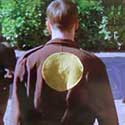Foreign prisoners of war held in Britain in World War Two

Prisoners of war in Britain - commonly known as POWs - were foreign military personnel captured by British forces overseas and brought back to Britain to spend the rest of the war in special camps. This page relies heavily on contributions from people who remember these POWs and their camps from their own childhood. It explores the POW uniforms, the work that the men did and how - perhaps surprisingly - they were often welcomed into the community. The page closes with their repatriation at the end of the war.
____
By the webmaster with firsthand recollections of from people who lived close to British POW camps as children and interacted with the POWs.
Prisoners of war were commonly known as POWs. That was just another term that I grew up with, probably because husbands and sons of people around me were in prisoners of war camps overseas.
There were of course POW camps in Britain for captured enemy troops, but I was too young to know much about them. What follows is by people, older than me, who lived near enough to the camps to remember them.
Prisoners of war uniforms

Uniform of foreign prisoners of war held in Britain
The yellow circular patch
contributed by Neil Cryer, recollections
The uniform of the POW camp close to where I lived near Cambridge was striking. It meant that any escaped POWs could be recognised at a glance from front or back. It was a dark suit like a boiler suit with a large yellow circle on the back and another on the front leg. I understand that the uniform was the same or similar across all POW camps.
The yellow diamond shaped patch
contributed by Donald Adams, recollections
As I recall, the prisoners of war working outside their camp had yellow diamond shape material stitched on their jackets. Incidentally the men were very friendly and showed me pictures of their children.
How POWs were occupied in useful work
Some of the things that found their way into our home when I was a child were made by prisoners of war. A wooden box that I still keep my needlework things in was one. So foreign the men were clearly given tools, equipment and tasks to as to be useful - although of course nothing directly to do with the war effort. As well as making things, they were put to work in the fields.
contributed by Bob Howard
My aunt who lived at a place called Barling near Southend had a pair of sandals made from an old tyre which came from the POW camp at Gt Wakering, and I had various things made by POWs at the camp in Rawreth Lane, Rayleigh. These included a small brown wooden money box and a miniature chest-of-drawers. The site of that camp is now an industrial site.
contributed by Malcolm Head
The POW camp that I knew was Ruperra Castle on the opposite side of the valley to the Cefn. The German prisoners were very clever and, having not a lot to occupy their minds, would make a wide range of toys.
Prisoners of war in the community
contributed by John Cole, personal recollections
The POW Camp in Edmonton where I lived was Italian and located at the Saracen Rugby ground in Firs Lane just behind the Edmonton Cemetery in Church Street. A family in the next road to us found one of its POWs wandering aimlessly on Christmas morning and invited him in to share in their Christmas dinner.
contributed by Gerald Ladd
I particularly remember the wooden huts for the prisoners of war on the Firs Lane camp site.
contributed by Malcolm Head
To me, listening to the hatred poured out by adults ('the only good German is a dead German') and the news and propaganda on the wireless, the prisoners at Ruperra Castle POW camp seemed surprisingly nice, polite and generally very pleasant men.
contributed by Dick Green, recollections
I regularly saw and chatted to Italian prisoners of war circa 1943-1944. This was along the A41 Watford bypass in Edgware. At the time I couldn't understand what they were doing. There was never any fear attached to these encounters. The men always seemed friendly.
POWs at the end of the war
contributed by Peter Johnson, recollections
It took some time for the foreign POWs to be repatriated and one of the tasks given to them while they were waiting was to knock down the brick air raid shelters and fill in and cover over the underground ones.
contributed by Donald Adams, recollections
During the war I sometimes stayed with my grandparents in the country at a place called Stocking Pellam near Bishops Stortford and there were two 18 year-old German POWs helping there. When the war ended they were both in tears at having to return to Germany. They were always very friendly towards me.
contributed by Donald Adams, recollections
After the war, my family lived in on the coast near Newquay and I used to talk to the Italian POWs who were removing barbed wire from the cliff top. Later they were repatriated.
| sources | webmaster | contact |
Text and images are copyright
If you can add anything to this page or provide a photo, please contact me.



